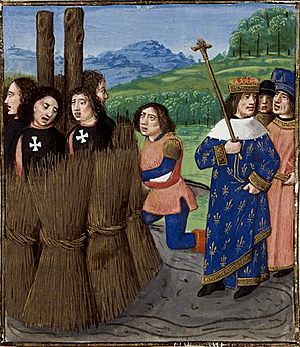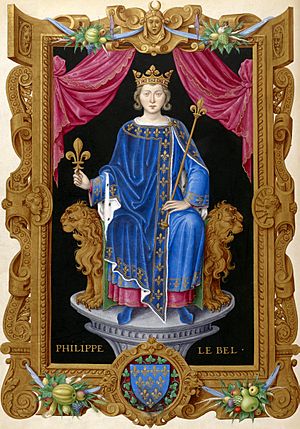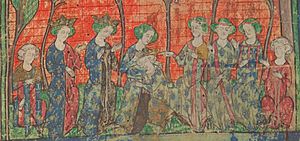Philip IV of France facts for kids
Quick facts for kids Philip IV |
|
|---|---|

Detail from a 1315 miniature
|
|
| King of France (more...) | |
| Reign | 5 October 1285 – 29 November 1314 |
| Coronation | 6 January 1286, Reims Cathedral |
| Predecessor | Philip III |
| Successor | Louis X |
| King of Navarre | |
| Reign | 16 August 1284 – 4 April 1305 |
| Predecessor | Joan I |
| Successor | Louis I |
| Co-monarch | Joan I |
| Born | 8 April – June 1268 Palace of Fontainebleau, France |
| Died | 29 November 1314 (aged 46) Fontainebleau, France |
| Burial | 3 December 1314 Saint Denis Basilica |
| Spouse | Joan I of Navarre (m. 1284, died 1305) |
| Issue among others... |
|
| House | Capet |
| Father | Philip III of France |
| Mother | Isabella of Aragon |
Philip IV (born between April and June 1268 – died 29 November 1314) was the King of France from 1285 to 1314. He was also known as Philip the Fair (Philippe le Bel) because he was considered handsome. However, his strong and serious personality also earned him the nickname the Iron King (le Roi de fer).
Philip wanted to make the king's power stronger. He worked to reduce the power of the rich nobles and the Church. He used skilled government workers to help him rule. Philip wanted France to be a united country with one strong ruler, not many powerful lords. He fought wars and limited the old feudal rights of his vassals (lords who owed him loyalty). This helped change France from a feudal country into a more centralized state. Philip also had a lot of influence in Europe and tried to place his family members on other thrones.
During his reign, Philip had important conflicts. He had a disagreement with King Edward I over lands in France. He also fought a war with the County of Flanders, who rebelled against him. Philip won this war and gained control of important Flemish cities. At home, he had conflicts with the Jews and the Knights Templar. He owed money to both groups. In 1306, he expelled the Jews from France. In 1307, he destroyed the Knights Templar. Philip also tried to tax the French clergy, which led to a big fight with Pope Boniface VIII. This conflict eventually led to the papal court moving to Avignon in 1309.
Philip's three sons became kings of France one after another: Louis X, Philip V, and Charles IV. They all died young without sons. This caused a problem for the French royal family and led to the Hundred Years' War (1337–1453).
Contents
Early Life
Philip was born in 1268 at the Palace of Fontainebleau in France. He was part of the House of Capet, a powerful royal family. His father was Philip III, who later became king. His mother was Isabella of Aragon. His grandfather was King Louis IX.
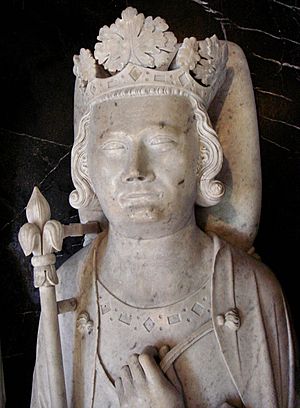
When Philip was two years old, his grandfather died, and his father became king. Philip's older brother, Louis, was the heir to the throne. Sadly, Philip's mother died a few months later. Then, his older brother Louis died in 1276 when Philip was eight. This made Philip the new heir to the throne of France.
Philip married Joan I of Navarre on 16 August 1284. They cared for each other, and Philip did not remarry after Joan died in 1305. Their marriage was important because Joan inherited the regions of Champagne and Brie. These lands were next to the king's own lands, which greatly expanded his kingdom and increased his income. Philip also gained the city of Lyon for France in 1312.
The Kingdom of Navarre in the Pyrenees mountains also became part of France through this marriage. It stayed connected to France for 44 years.
Becoming King
Philip became King of France at 17 years old. He was crowned on 6 January 1286, in Reims. As king, Philip was determined to make the monarchy (the king's rule) as strong as possible. He relied on professional government workers and lawyers more than any king before him. He often let his ministers handle specific policies, especially unpopular ones. Some people at the time called him a "useless owl" because he seemed distant. His reign was a time when France changed from a kingdom that depended on a strong, popular king to a more organized government with many officials.
Foreign Affairs and Wars
War with England
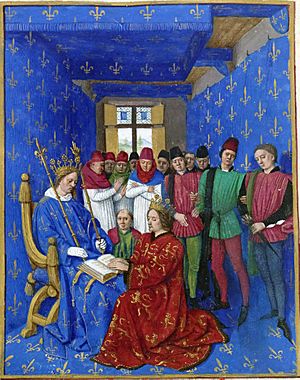
King Edward I was also the Duke of Aquitaine, a region in southwestern France. This meant he was Philip's vassal and had to show loyalty to the French king. In 1293, after a fight between English and Norman sailors, Philip ordered Edward to come to the French court. Edward sent his representatives, but Philip refused to negotiate. He treated Edward only as a vassal.
Edward then tried to use family connections to avoid war. He sent his brother, Edmund, who was related to Philip's family. An agreement was made that Edward would give up Gascony (part of Aquitaine) to Philip as a sign of loyalty. In return, Philip would forgive Edward and give Gascony back later. However, Philip had no intention of returning the land. He used the excuse that Edward had not come to court himself to take all of Edward's lands in France. This started a war with England in 1294.
The war over Gascony lasted from 1294 to 1303. Philip gained some land, but later had to return it due to revolts. To pay for these wars, Philip needed a lot of money.
To make peace, Philip's daughter Isabella married the Prince of Wales (Edward I's heir) in 1308. This marriage was supposed to bring peace, but it eventually led to an English claim to the French throne and the start of the Hundred Years' War.
War with Flanders
Philip faced a big defeat in 1302 when his army was beaten by the Flemish in the Battle of the Golden Spurs. This battle happened near Kortrijk. Philip responded strongly to this loss. Two years later, in 1304, the Battle of Mons-en-Pévèle resulted in a clear French victory.
Because of this victory, Philip forced the Flemish to accept a harsh peace treaty in 1305. This treaty made them pay a lot of money and give up important cities like Lille, Douai, and Bethune to the French crown.
Diplomacy with Mongols
Philip had some contact with the Mongol leaders in the Middle East. He met with a Mongol monk named Rabban Bar Sauma, who came from China. Bar Sauma offered an alliance between the Mongols and Europeans against their common enemy, the Muslim Mamluks. The Mongols promised to return Jerusalem to the Christians if they won. Philip seemed interested and sent one of his noblemen with Bar Sauma back to Mongol lands. There were more letters exchanged, but Philip never actually sent troops to help.
In 1305, a new Mongol ruler, Öljaitü, again offered to work with European Christian nations against the Mamluks. European countries tried to start another Crusade, but it was delayed and never happened. In 1313, Philip promised to go on a Crusade himself, but he died soon after in a hunting accident.
Money and Religion
Financial Challenges
Philip IV inherited a large debt from his father's war. To pay for his constant wars against Aragon, England, and Flanders, Philip faced many financial problems. He borrowed a lot of money from bankers, including the Knights Templar and later Florentine bankers.
To get more money, Philip sometimes reduced the amount of silver in coins. This made the coins worth less and caused prices to rise. This was hard on people who had lent money, as they were paid back with weaker currency. It also caused social unrest. For example, in 1306, there were riots in Paris because of these changes to the money.
Philip also took drastic measures to raise money. In 1306, he ordered the expulsion of the Jews from France and took their property. This brought a lot of money to the crown.
Conflict with the Pope
When Philip tried to tax the French clergy (Church officials) heavily, it caused a big argument with Pope Boniface VIII. The Pope issued a special order called Clericis Laicos in 1296, which said that no Church property could be given to the French Crown. Philip fought back by stopping all gold and silver from leaving France. By 1297, the Pope agreed that Philip could tax the clergy in emergencies.
The conflict continued. In 1301, Philip arrested a bishop for treason. The Pope called French bishops to Rome to discuss Philip's actions. In response, Philip gathered an assembly of bishops, nobles, and important citizens in Paris to condemn the Pope. This assembly, which was a very early form of the Estates General, supported Philip.
The Pope responded with another important order, Unam Sanctam (1302), which declared the Pope's supreme authority. Philip then sent his agent, Guillaume de Nogaret, to arrest Boniface at Anagni. The Pope escaped but died soon after. A French archbishop was then elected as Pope Clement V. This led to the papal court moving to Avignon in 1309, a place surrounded by French lands. This meant the Pope was now under French influence.
Suppression of the Knights Templar
Philip owed a lot of money to the Knights Templar. This was a powerful military and banking order that had become very wealthy. As the Crusades became less popular, support for military orders like the Templars decreased. Philip used complaints against the Templars as an excuse to move against them. He wanted to get rid of his debts and gain control of their wealth.
On Friday, 13 October 1307, hundreds of Templars in France were arrested by Philip's agents. The Templars were supposed to answer only to the Pope. However, Philip used his influence over Clement V, who was largely under his control, to disband the order. Pope Clement tried to hold proper trials, but Philip used forced confessions to have many Templars executed before they could defend themselves.
In March 1314, Philip had Jacques de Molay, the last Grand Master of the Templars, and Geoffroi de Charney burned at the stake.
Pope Clement V died a little over a month later. Eight months after that, Philip IV died at the age of 46. This led to a popular legend that de Molay had cursed them both to appear before God's judgment. Within fourteen years, Philip's sons, who died relatively young and without male heirs, quickly passed the throne between them. By 1328, Philip's direct male line ended, and the throne passed to his brother's family, the House of Valois.
Death
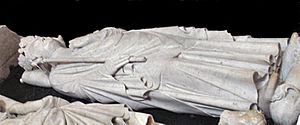
Philip had a stroke while hunting near Pont-Sainte-Maxence. He died a few weeks later, on 29 November 1314, at Fontainebleau. He was buried in the Basilica of St Denis. His son, Louis X, became the next king.
Family
Philip IV of France and Joan I of Navarre had the following children:
- Margaret (born around 1288, died after November 1294).
- Louis X (born 4 October 1289 – died 5 June 1316).
- Blanche (born 1290, died after 13 April 1294).
- Philip V (born around 1291 – died 3 January 1322).
- Charles IV (born 1294 – died 1 February 1328).
- Isabella (born around 1295 – died 23 August 1358). She married Edward II of England and was the mother of Edward III of England.
- Robert (born 1296, died August 1308).
All three of Philip's sons who lived to be adults became kings of France. Isabella, his only daughter who survived, became the queen of England.
Images for kids
-
Donation made by King Philip IV the Fair to the chaplains of the Sainte-Chapelle in Paris. February 1286.
See also
 In Spanish: Felipe IV de Francia para niños
In Spanish: Felipe IV de Francia para niños



